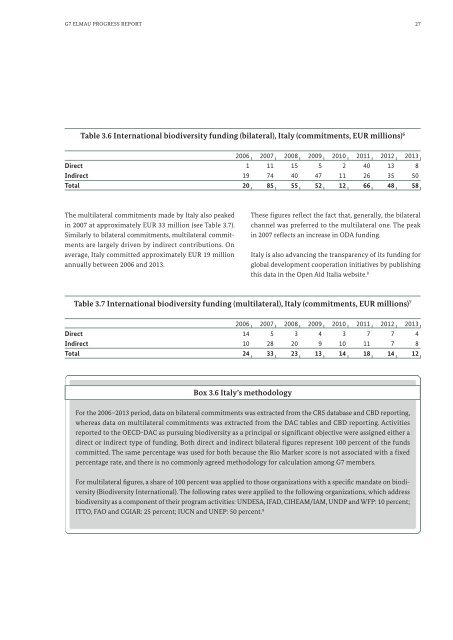26 <strong>G7</strong> ELMAU PROGRESS REPORT3.6 Italy3.6.1 Priorities of Italy’s biodiversity fundingItaly’s strategy on biodiversity is being pursued, in particular,at the policy level through its support <strong>for</strong> biodiversityrelatedMultilateral Environmental Agreements – especiallythe CBD (see also Italy 2014) and the Convention onMigratory Species – as well as through the implementationof its strategic framework, with a special focus onprotected areas and migratory species. Over the years, Italyhas also been committed in particular to mainstreamingenvironmental issues into its <strong>development</strong> cooperationinitiatives using a comprehensive approach. Hence, biodiversityconcerns have been integrated into cooperationinitiatives that address all other environment-relatedthemes, such as climate change, <strong>sustainable</strong> infrastructure,agriculture, food and nutritional security, and economic<strong>development</strong>, in order to pursue a unified <strong>development</strong>approach.In 2011, as the overarching goal of its <strong>development</strong> cooperationaction, Italy approved environmental guidelinesthat focus on <strong>sustainable</strong> <strong>development</strong>. These guidelineswere designed as a tool to identify, approve, monitor andevaluate all Italian environmental initiatives as well asto strengthen the mainstreaming of environmental issues inall other initiatives. Particular attention is given toinitiatives that consider the environment as an economicopportunity, where a green economy is also promoted. Italycontributes to the protection of biological diversity throughspecific initiatives that focus on: the protection of endangeredspecies and the <strong>sustainable</strong> management of naturalresources in biodiversity hotspots and ecosystems; theeradication and control of invasive alien species; the promotionof transboundary initiatives to enhance dialogueand collaboration in areas experiencing high levels ofpolitical tension; as well as the support of global mechanisms<strong>for</strong> the <strong>sustainable</strong> <strong>development</strong> of fragile ecosystems,such as the Global Island Partnership and theMountains Partnership.Since 1974, Italy has also been hosting and supporting<strong>Biodiversity</strong> International, a global research-<strong>for</strong>-<strong>development</strong>organization established as the InternationalBoard <strong>for</strong> Plant Genetic Resources. Its mission is to coordinatean international plant genetic resources program,including emergency collection missions, and to buildand expand national, regional and international genebanks.3.6.2 Financial flowsThe bilateral commitments made by Italy peaked in 2007at approximately EUR 85 million, with the second-largestbilateral contribution coming in 2011 at EUR 66 million(see Table 3.6). This level was almost reached again in 2013.The Italian bilateral contributions are largely driven bythe great share of commitments classified as indirect / significant.On average, the Italian government committedalmost EUR 50 million per year in the period from 2006to 2013. In this respect, it is worth mentioning the importantrole that Italian contributions played <strong>for</strong> the GEF.These numbers reflect the fact that biodiversity is one ofthe many priorities of Italian Development Cooperation.Peaks in 2007 and 2011 reflect large soft-loan commitments,whereas the low level of funding in 2010 reflects areduction in bilateral ODA as well as in the total numberand size of commitments classified as “biodiversity significant.”Sustainable use and conservation of genetic material <strong>for</strong> agro-biodiversity. Italy.Italian Development Cooperation
<strong>G7</strong> ELMAU PROGRESS REPORT 27Table 3.6 International biodiversity funding (bilateral), Italy (commitments, EUR millions) 62006 2007 2008 2009 2010 2011 2012 2013Direct 1 11 15 5 2 40 13 8Indirect 19 74 40 47 11 26 35 50Total 20 85 55 52 12 66 48 58The multilateral commitments made by Italy also peakedin 2007 at approximately EUR 33 million (see Table 3.7).Similarly to bilateral commitments, multilateral commitmentsare largely driven by indirect contributions. Onaverage, Italy committed approximately EUR 19 millionannually between 2006 and 2013.These figures reflect the fact that, generally, the bilateralchannel was preferred to the multilateral one. The peakin 2007 reflects an increase in ODA funding.Italy is also advancing the transparency of its funding <strong>for</strong>global <strong>development</strong> cooperation initiatives by publishingthis data in the Open Aid Italia website. 8Table 3.7 International biodiversity funding (multilateral), Italy (commitments, EUR millions) 72006 2007 2008 2009 2010 2011 2012 2013Direct 14 5 3 4 3 7 7 4Indirect 10 28 20 9 10 11 7 8Total 24 33 23 13 14 18 14 12Box 3.6 Italy’s methodologyFor the 2006–2013 period, data on bilateral commitments was extracted from the CRS database and CBD reporting,whereas data on multilateral commitments was extracted from the DAC tables and CBD reporting. Activitiesreported to the OECD-DAC as pursuing biodiversity as a principal or significant objective were assigned either adirect or indirect type of funding. Both direct and indirect bilateral figures represent 100 percent of the fundscommitted. The same percentage was used <strong>for</strong> both because the Rio Marker score is not associated with a fixedpercentage rate, and there is no commonly agreed methodology <strong>for</strong> calculation among <strong>G7</strong> members.For multilateral figures, a share of 100 percent was applied to those organizations with a specific mandate on biodiversity(<strong>Biodiversity</strong> International). The following rates were applied to the following organizations, which addressbiodiversity as a component of their program activities: UNDESA, IFAD, CIHEAM/IAM, UNDP and WFP: 10 percent;ITTO, FAO and CGIAR: 25 percent; IUCN and UNEP: 50 percent. 9


